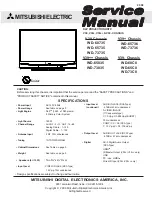
VDCPTOV function has a block input (BLOCK) where a fuse failure supervision (or MCB tripped)
can be connected to prevent problems if one fuse in the capacitor bank voltage transformer
set has opened and not the other (capacitor voltage is connected to input U2). It will also
ensure that a fuse failure alarm is given instead of a Undervoltage or Differential voltage alarm
and/or tripping.
8.4.3
Setting guidelines
SEMOD153915-5 v3
The parameters for the voltage differential function are set via the local HMI or PCM600.
The following settings are done for the voltage differential function.
Operation: Off/On
GlobalBaseSel: Selects the global base value group used by the function to define IBase, UBase
and
SBase. Note that this function will only use IBase value.
BlkDiffAtULow: The setting is to block the function when the voltages in the phases are low.
RFLx: Is the setting of the voltage ratio compensation factor where possible differences
between the voltages is compensated for. The differences can be due to different voltage
transformer ratios, different voltage levels e.g. the voltage measurement inside the capacitor
bank can have a different voltage level but the difference can also e.g. be used by voltage drop
in the secondary circuits. The setting is normally done at site by evaluating the differential
voltage achieved as a service value for each phase. The factor is defined as U2 ·
RFLx and shall
be equal to the U1 voltage. Each phase has its own ratio factor.
UDTrip: The voltage differential level required for tripping is set with this parameter. For
application on capacitor banks the setting will depend of the capacitor bank voltage and the
number of elements per phase in series and parallel. Capacitor banks must be tripped before
excessive voltage occurs on the healthy capacitor elements. The setting values required are
normally given by the capacitor bank supplier. For other applications it has to be decided case
by case. For fuse supervision normally only the alarm level is used.
tTrip: The time delay for tripping is set by this parameter. Normally, the delay does not need to
be so short in capacitor bank applications as there is no fault requiring urgent tripping.
tReset: The time delay for reset of tripping level element is set by this parameter. Normally, it
can be set to a short delay as faults are permanent when they occur.
For the advanced users following parameters are also available for setting. Default values are
here expected to be acceptable.
U1Low: The setting of the undervoltage level for the first voltage input is decided by this
parameter. The proposed default setting is 70%.
U2Low: The setting of the undervoltage level for the second voltage input is decided by this
parameter. The proposed default setting is 70%.
tBlock: The time delay for blocking of the function at detected undervoltages is set by this
parameter.
UDAlarm: The voltage differential level required for alarm is set with this parameter. For
application on capacitor banks the setting will depend of the capacitor bank voltage and the
number of elements per phase in series and parallel. Normally values required are given by
capacitor bank supplier.
For fuse supervision normally only this alarm level is used and a suitable voltage level is 3-5% if
the ratio correction factor has been properly evaluated during commissioning.
Section 8
1MRK 505 370-UEN D
Voltage protection
218
Busbar protection REB670
Application manual
Summary of Contents for REB670 Series
Page 1: ...Relion 670 SERIES Busbar protection REB670 Version 2 2 IEC Application manual ...
Page 2: ......
Page 22: ...16 ...
Page 64: ...58 ...
Page 226: ...220 ...
Page 244: ...238 ...
Page 358: ...352 ...
Page 392: ...386 ...
Page 398: ...392 ...
Page 436: ...430 ...
Page 454: ...448 ...
Page 466: ...460 ...
Page 474: ...468 ...
Page 475: ...469 ...
















































